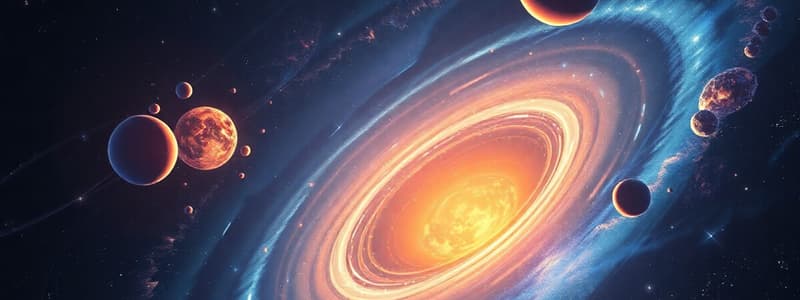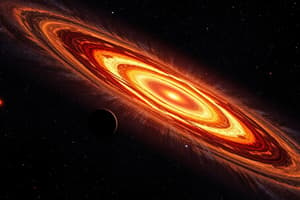Podcast
Questions and Answers
Who first proposed the Nebular Theory?
Who first proposed the Nebular Theory?
- Immanuel Kant
- Albert Einstein
- Pierre-Simon Laplace
- Emanuel Swedenborg (correct)
The Nebular Theory suggests the Solar System is formed from solid rocks orbiting the Sun.
The Nebular Theory suggests the Solar System is formed from solid rocks orbiting the Sun.
False (B)
In which year did Immanuel Kant publish his work on the Nebular Hypothesis?
In which year did Immanuel Kant publish his work on the Nebular Hypothesis?
1755
Pierre-Simon Laplace modified Kant's idea in _____ (year).
Pierre-Simon Laplace modified Kant's idea in _____ (year).
Match the following scientists with their contributions to the Nebular Theory:
Match the following scientists with their contributions to the Nebular Theory:
What is the primary concept of the Nebular Theory?
What is the primary concept of the Nebular Theory?
Emanuel Swedenborg proposed the idea that the universe formed from solid objects.
Emanuel Swedenborg proposed the idea that the universe formed from solid objects.
Who further developed the Nebular Theory after Emanuel Swedenborg?
Who further developed the Nebular Theory after Emanuel Swedenborg?
Pierre-Simon Laplace modified Kant's ideas in _____ (year).
Pierre-Simon Laplace modified Kant's ideas in _____ (year).
What did Pierre-Simon Laplace suggest about the formation of the Sun and planets?
What did Pierre-Simon Laplace suggest about the formation of the Sun and planets?
The Nebular Theory states that the planets formed independently of the Sun.
The Nebular Theory states that the planets formed independently of the Sun.
In which publication did Immanuel Kant describe the Nebular Hypothesis?
In which publication did Immanuel Kant describe the Nebular Hypothesis?
The theory suggests a nebula condensed into rings, which formed the _____ and a central mass.
The theory suggests a nebula condensed into rings, which formed the _____ and a central mass.
Match the following scientists with their contributions to the Nebular Theory:
Match the following scientists with their contributions to the Nebular Theory:
What phenomenon does the term 'nebula' refer to in the context of the Nebular Theory?
What phenomenon does the term 'nebula' refer to in the context of the Nebular Theory?
Who was the first scientist to propose the idea that the universe was formed by clouds of gas?
Who was the first scientist to propose the idea that the universe was formed by clouds of gas?
In which year did Immanuel Kant further develop the Nebular Theory?
In which year did Immanuel Kant further develop the Nebular Theory?
What did Pierre-Simon Laplace suggest about the formation of the Sun and planets?
What did Pierre-Simon Laplace suggest about the formation of the Sun and planets?
What concept was emphasized in Kant's work related to the Solar System formation?
What concept was emphasized in Kant's work related to the Solar System formation?
Which modification did Pierre-Simon Laplace make to Kant's theory?
Which modification did Pierre-Simon Laplace make to Kant's theory?
Which publication first presented Kant's ideas about the Nebular Theory?
Which publication first presented Kant's ideas about the Nebular Theory?
What year did Pierre-Simon Laplace modify Kant's ideas on the Nebular Theory?
What year did Pierre-Simon Laplace modify Kant's ideas on the Nebular Theory?
Which philosopher first described the idea of the universe formed by clouds of gas?
Which philosopher first described the idea of the universe formed by clouds of gas?
How did the theory describe the formation of the Solar System?
How did the theory describe the formation of the Solar System?
What was the focus of Laplace's modifications to the Nebular Theory?
What was the focus of Laplace's modifications to the Nebular Theory?
Flashcards are hidden until you start studying
Study Notes
Nebular Theory
- The Nebular Theory suggests that the Solar System was formed from gas and dust orbiting the Sun.
- Emanuel Swedenborg was the first to describe the universe forming from clouds of gas in 1734.
- Immanuel Kant further developed Swedenborg's idea in 1755, proposing that the gas and dust clumped together to form planets.
- Pierre-Simon Laplace modified Kant's theory in 1796, suggesting that the Sun and planets formed in a rotating nebula that cooled and collapsed.
- Laplace argued that the nebula condensed into rings which eventually formed the planets and a central mass, the Sun.
The Nebular Theory
- The Nebular Theory was proposed by Swedish philosopher Emmanuel Swedenborg in 1734.
- Swedenborg was the first to suggest the formation of the universe from clouds of gas.
- The theory was further developed by Immanuel Kant in 1755, who proposed the Solar System formed from dust and gas orbiting the Sun. This material eventually clumped together to form the planets.
- Kant's work, "Universal Natural History and Theory of the Heavens" (1755), outlined his theory.
- Pierre Laplace modified Kant's theory in 1796, suggesting the Sun and planets formed from a rotating nebula that cooled and collapsed.
- Laplace argued that this nebula condensed into rings, which then formed the planets and a central mass - the Sun.
The Nebular Theory
- The Nebular Theory suggests the Solar System was formed from rotating gas and dust orbiting the Sun.
- The theory was first proposed by Emanuel Swedenborg in 1734.
- Immanuel Kant further developed the theory in 1755 in his book "Universal Natural History and Theory of the Heavens."
- Pierre Laplace modified the theory in 1796 arguing the nebula condensed into rings, which eventually formed the planets and a central mass - the Sun.
Studying That Suits You
Use AI to generate personalized quizzes and flashcards to suit your learning preferences.




